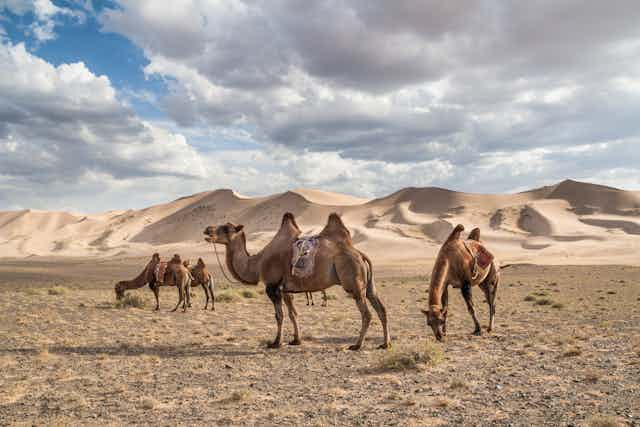Around 34 million years ago, sudden climate change caused ecological breakdown in Central Asia. This ancient event, triggered by rapid drops in temperature and atmospheric carbon dioxide, permanently affected biological diversity in the region. Large areas of Mongolia, (geographic) Tibet and north-western China suddenly became hyperarid deserts with little vegetation cover – and stayed that way for almost 20 million years.
This was a surprising finding of new research I carried out with colleagues from across Europe and China, in which we reconstructed the past 43 million years of evolutionary history for the steppe, semi-desert and desert ecosystems of Central Asia (the biogeographical and political conceptions of “Central Asia” differ and we use the former: our research area is shown below).
Many scientists had previously thought that this region was forested for much of that time and only grew drier later on, culminating today in massive, exceptionally arid Asian deserts such as the Gobi and Taklimakan.

We found that fossil pollen combined with mammal fossils, geological and climatic evidence – all preserved inside ancient rocks – told a different tale. Ancient “wet” steppe-deserts that received enough precipitation to maintain high biodiversity already existed during the late Eocene (40 to 34 million years ago), but suddenly became much colder and drier over an event called the Eocene‒Oligocene Transition (EOT).
Scientists already knew that global climate cooling in this period caused the formation of a permanent Antarctic ice-sheet, but what happened on different continents is less clear. Our new study found that the lowlands of Central Asia became hyperarid deserts with little vegetation cover. The lack of food resources meant that larger animals were mainly replaced by small mammals like rodents, rabbits and hares.

This hyperaridity lasted for millions of years afterwards, and plants only recovered when the climate became temporarily wetter around 15 million years ago. But now, the major species were small, non-woody herbs, not the salt and drought- tolerant shrubs that had dominated before the ecological collapse. Despite large parts of Central Asia being very dry today, these shrubs (Nitraria and Ephedra) never again recovered their position of ecological prominence. We still don’t fully understand why, but it shows that populations can be permanently altered by sudden environmental changes even if widespread extinctions don’t occur.
This finding is particularly relevant today, because atmospheric carbon dioxide levels and climate are again changing rapidly. Given what we now know about the Asian steppe-desert’s climatic and ecological history, it is unlikely that these ecosystems will ever recover their present biological diversity if forced into a new state.
History repeats itself
The modern steppe-desert is the largest ecoregion of its kind in the world, hosting a lot more biodiversity than you might expect. Dry-adapted grasses and herbs support an array of wildlife, many of which are endemics (native to, and living only in, that region). These unique flora and fauna have evolved partly as a result of immense geological and climatic diversity: today Central Asia is home to some of the oldest deserts known, as well as the highest mountains outside of the Himalayas.

Ancient climate change and geological forces have shaped the steppe-desert through time. The collision of India with Asia, formation of the Tibetan Plateau and uplift of the Himalaya, Altai and Hangay mountain ranges created extreme altitudinal variation, as well as distinct rain shadows of dry land on the downwind side. This generated a mosaic of habitats, and in turn, an astonishing number of species who call the region home.
But now the steppe-desert’s biodiversity is under severe threat from human-induced climate change and land degradation. Growing seas of sand are claiming native steppes, imposing desertification at unprecedented rates. Evidence from the past shows us that this is a sign of impending ecosystem breakdown – and it will cause irreversible changes and loss of biodiversity if allowed to continue.
Claimed by the desert
Desertification in Asia has major implications for humans too. It now threatens almost half a billion people, many of whom are finding it increasingly difficult to make a living in communities dominated by agriculture. Crops are ravaged by drought, livestock are losing grazing pastures, and deserts are growing towards the cities.

Model predictions from the Intergovernmental Panel on Climate Change (IPCC) and recent climate records show that interior Asia is fast becoming one of the hottest and driest places on the planet. Major predicted changes include highly reduced vegetation cover and rapid, severe species losses, along with more unreliable rainfall and high dust emissions generated by widespread desertification and erosion.
This new hyperarid desert ecosystem phase would resemble the inhospitable, barren landscapes that spread 34 million years ago. Lessons from the past make it clear that current human-induced global changes must be urgently halted in order to preserve the Asian steppe, which has now become one of the world’s most endangered habitats.

